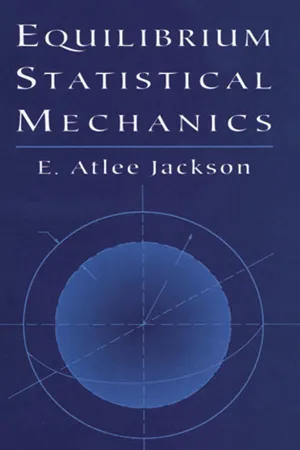
- 272 pages
- English
- ePUB (mobile friendly)
- Available on iOS & Android
Equilibrium Statistical Mechanics
About this book
Ideal as an elementary introduction to equilibrium statistical mechanics, this volume covers both classical and quantum methodology for open and closed systems. Introductory chapters familiarize readers with probability and microscopic models of systems, while additional chapters describe the general derivation of the fundamental statistical mechanics relationships. The final chapter contains 16 sections, each dealing with a different application, ordered according to complexity, from classical through degenerate quantum statistical mechanics. Key features include an elementary introduction to probability, distribution, functions, and uncertainty prior to a discussion of statistical mechanics; a review of the concept and significance of energy, together with a discussion of various models of physical systems. A series of appendixes contains helpful information on Gaussian integrals, the error function, the entropy constant, solutions to problems, and other subjects.
A background in integral calculus is assumed, but because material is presented at a reasonable level of complexity, even readers not familiar with quantum mechanics can make use of at least two-thirds of this book. Index. 5 Appendixes. Problems at ends of chapters. Over 100 text figures.
Frequently asked questions
- Essential is ideal for learners and professionals who enjoy exploring a wide range of subjects. Access the Essential Library with 800,000+ trusted titles and best-sellers across business, personal growth, and the humanities. Includes unlimited reading time and Standard Read Aloud voice.
- Complete: Perfect for advanced learners and researchers needing full, unrestricted access. Unlock 1.4M+ books across hundreds of subjects, including academic and specialized titles. The Complete Plan also includes advanced features like Premium Read Aloud and Research Assistant.
Please note we cannot support devices running on iOS 13 and Android 7 or earlier. Learn more about using the app.
Information
1
Probability
1. FREQUENCY AND PROBABILITY

Table of contents
- Title Page
- Copyright Page
- Dedication
- Preface
- Table of Contents
- Introduction
- 1 - Probability
- 2 - Energy
- 3 - Statistical Mechanics
- 4 - Applications of Statistical Mechanics
- Appendices
- INDEX
- Physical Constants and Conversion Factors